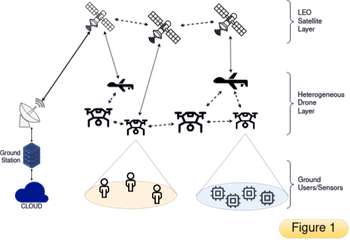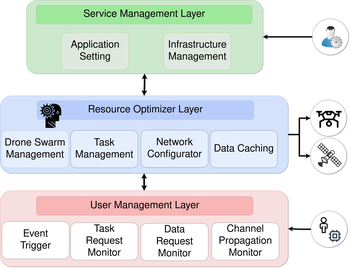The project

Project Overview
The RAIN4C project aims to address the critical need for reliable network connectivity in harsh environments, such as post-disaster areas or rural locations. By leveraging a dynamic multi-layer architecture composed of ground, aerial, and satellite segments, RAIN4C provides a robust communication, computation, and caching system. This innovative framework integrates the capabilities of drone swarms and satellite networks to ensure reliable connectivity and efficient resource management in critical scenarios.
Objectives
The RAIN4C project has three main objectives:
- Multi-layer Network System Design: Develop a network system composed of satellite and drone swarm layers, focusing on reliable connectivity, computation, and caching.
- Performance Enhancement: Design a satellite-to-drone-to-ground system that optimizes radio and computational resources, ensuring efficient service delivery under various constraints.
- Proof-of-Concept Implementation: Validate the system through simulations and real-world tests using existing satellite networks and UAVs.
Methodology
To achieve its objectives, RAIN4C will:
- Design a modular Non-Terrestrial Network (NTN) architecture integrating ground users, UAVs, and satellites.
- Conduct state-of-the-art analysis and develop key components for reliable communication, computation offloading, and data caching.
- Implement and validate the proposed system through simulations and real-world deployments, focusing on the performance in critical scenarios.

Key Components
User Management Layer (UML)
Manages user requests, data needs, and channel conditions, ensuring efficient interaction with the ground users.
Service Management Layer (SML)
Oversees the system’s operations, defining and updating the aerial-satellite infrastructure and managing application settings.
Resource Optimizer Layer (ROL)
Optimizes network configurations, drone swarm management, task execution, and data caching to maximize system performance and resource efficiency.
Results and Impact
The RAIN4C project is expected to:
- Advance the state-of-the-art in multi-layer network architectures.
- Develop novel algorithms for resource optimization in complex networks.
- Provide a proof-of-concept for deployable solutions in critical scenarios.
- Publish findings in peer-reviewed journals and conferences, contributing significantly to scientific knowledge and technological innovation.